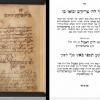7: Excerpt of Hayyim Hamel's manuscript of Glückel’s memoirs, 18th Century, and excerpt from the first printed version, late 19th Century.
Glückel’s memoir was written in Old Yiddish, or Western Yiddish, and is rich in Hebrew elements and quotations from the scriptures, as well as legends, parables, and proverbs that she quotes to bolster her opinions and perspectives. Glückel handwrote her memoirs over decades. The original manuscript has not been preserved, but at least two copies were made: one by her son Moshe and another by her grandson Hayyim. Those copies were passed down from generation to generation until they reached the late nineteenth century scholar David Kaufmann, who published the memoirs in 1896. The images below are of the version transcribed by Hayyim Hamel, and the corresponding page from Kaufmann’s published version.
Suggested Activities: Use these images as an opportunity for your students to think about manuscripts as objects with lives of their own. Ask the students to imagine how this text was preserved to the present day. What objects do they have in their homes that are very old? Where do these objects come from? How do they get preserved? What objects from their families' past may have been discarded or lost? How do they think the historical record is shaped by what gets preserved and what is lost?
Invite your students to participate in a manuscript copying activity (adapted from the Piers Plowman Electronic Archive). Write out, by hand, a few sentences from one of the above translated excerpts of Glückel’s memoir. Hand your copy to a student and ask him or her to copy it over. Then, ask that student to hand the paper to the next student to copy over. Then, ask the class to compare the copies to the original. What gets preserved, and what does not? Ask them to think not only about errors in the words of the text but also about punctuation, spacing, and the physical appearance of the paper and handwriting. You may want to continue the activity by asking a third or fourth student to copy the manuscript while thinking about how they would want to edit or improve it so that future readers might think more highly of Glückel. If they were copying with this intention of improving, what historical information might get lost or changed?
Ask your students to compare the manuscript and print versions. What information can they learn from each? How is the experience of looking at a manuscript different from print? How are each of these experiences different from reading a text digitally? Invite your students to rewrite one of the above excerpts as a blog, tumblr, tweetstorm or facebook post. How might Glückel have expressed herself differently using digital media?
Sources: Manuscript: Memoirs of Gluckel of Hameln. Scribe: Hayyim Hamel, Baiersdorf, 18th Century. Frankfurt-am-Main University Library, digital edition, 2011.
Die Memoiren der Gluckel von Hameln (1645-1719), David Kaufmann, ed. (J. Kaufmann: Frankfurt-am-Main, 1896).

